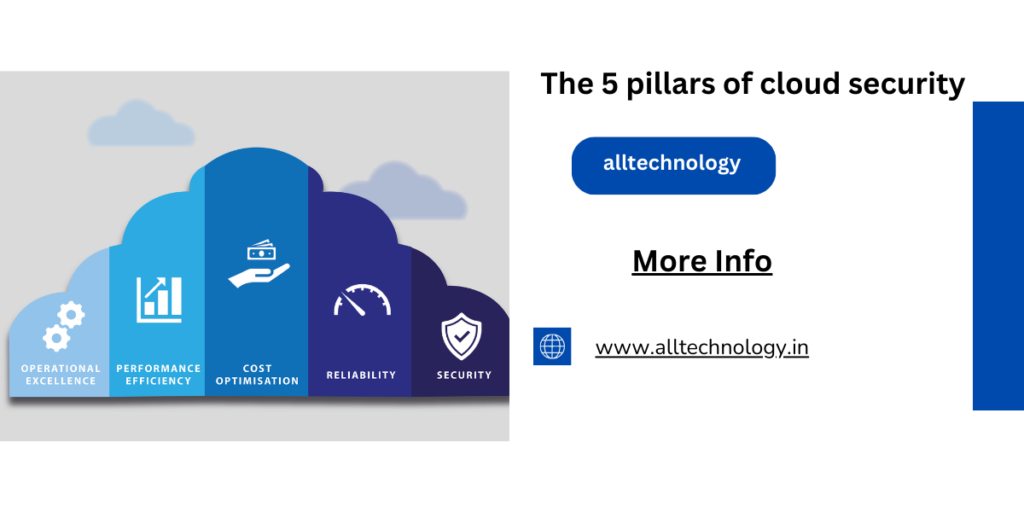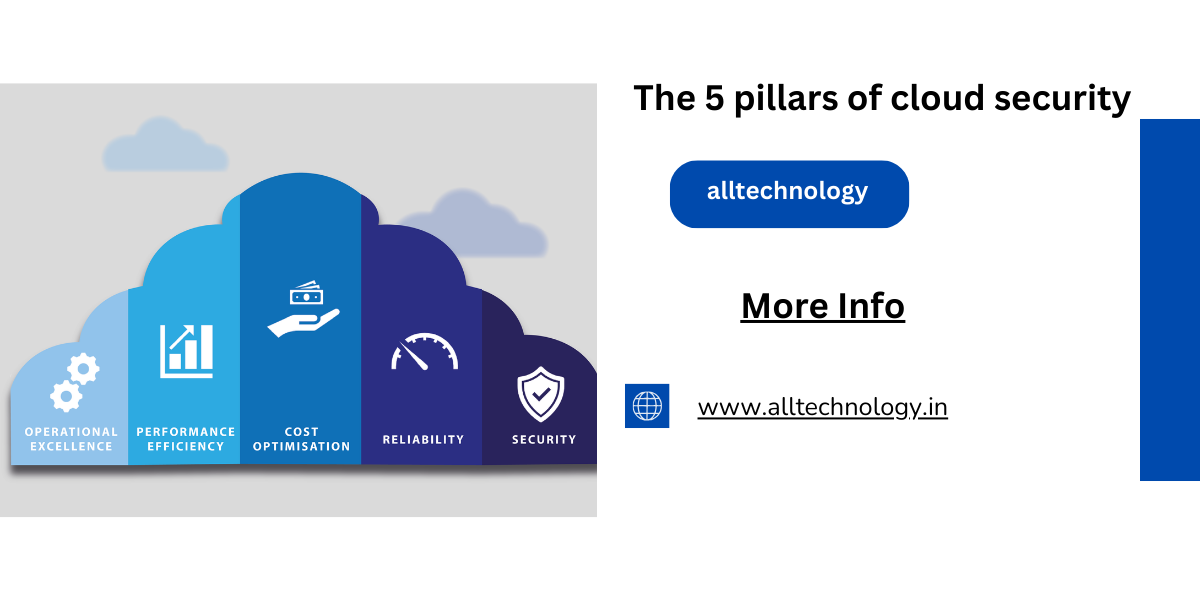Introduction
Hello Bloggers welcome alltechnology blog. In this blog you will learn The 5 pillars of cloud security. In the digital age, where data is the currency and cloud technology the cornerstone, the imperative of robust security measures cannot be overstated. As businesses increasingly migrate their operations to cloud environments, ensuring the integrity, confidentiality, and availability of data becomes paramount. Enter the realm of cloud security, where the landscape is defined by five fundamental pillars, each representing a crucial aspect of fortification against the myriad threats lurking in the virtual ether.

Pillar 1: Perimeter Security Reinvented
At the forefront stands perimeter security, the traditional guardian of network boundaries. Yet, in the realm of cloud computing, the notion of perimeters undergoes a metamorphosis, morphing from physical barriers to virtual fortresses. Here, the concept of perplexity emerges, as the boundaries blur between internal and external networks, demanding a paradigm shift in defense strategies. Burstiness ensues as we navigate the complexities of micro-segmentation, zero-trust architectures, and the intricate dance of access controls in a dynamic, elastic environment.
Pillar 2: Data Encryption: Safeguarding the Digital Treasury
Amidst the nebulous expanse of the cloud, data emerges as both the lifeblood and the Achilles’ heel of enterprises. In this labyrinth of bytes and bits, encryption emerges as the stalwart sentinel, shrouding sensitive information in layers of cryptographic armor. Yet, the landscape is far from monolithic; herein lies the burstiness, as we traverse the myriad encryption protocols, from AES to RSA, navigating the delicate balance between security and performance, all while contending with the ever-looming specter of quantum computing.
Pillar 3: Identity and Access Management: The Sentinel at the Gate
In the kingdom of cloud security, the principle of least privilege reigns supreme, dictating that access be granted only on a need-to-know basis. Here, the dance of identity and access management unfolds, a tapestry woven with threads of perplexity and burstiness. From multi-factor authentication to role-based access controls, the landscape teems with complexity, as we grapple with the nuances of user provisioning, authentication protocols, and the delicate orchestration of permissions across diverse cloud environments.
In the tempest-tossed seas of cyberspace, breaches and disasters loom on the horizon, threatening to engulf the unwary. Here, the art of incident response and disaster recovery takes center stage, a symphony of preparedness and resilience. As we plunge into the depths of incident detection, containment, and remediation, the waters churn with perplexity, while the cadence of response plans and recovery strategies lends a rhythm of burstiness to the narrative.
Pillar 5: Compliance and Governance: Upholding the Digital Mandate
In the labyrinthine corridors of regulatory frameworks and industry standards, compliance emerges as the lodestar guiding enterprises through the fog of legal obligations and ethical imperatives. Here, the interplay of perplexity and burstiness is palpable, as we navigate the ever-shifting landscape of compliance requirements, from GDPR to HIPAA, threading the needle between data sovereignty and transnational data flows, all while grappling with the kaleidoscope of auditing and reporting obligations.
- Identity and Access Management (IAM): Unlocking the Gates IAM stands as the vanguard of cloud security, controlling who has access to what resources and under what circumstances. From multi-factor authentication to role-based access control, IAM mechanisms serve as the digital gatekeepers, ensuring only authorized users gain entry while thwarting potential intruders. Imagine a fortress where each individual must present their credentials before crossing the drawbridge; IAM operates on a similar principle, fortifying the perimeter and mitigating unauthorized access attempts.
- Data Encryption: Shielding the Digital Vault In the digital age, data reigns supreme, and its protection is non-negotiable. Encryption acts as the cloak of invisibility, rendering sensitive information indecipherable to prying eyes. Whether data is at rest or in transit, encryption algorithms scramble the contents into an unintelligible jumble, accessible only to those possessing the cryptographic keys. Picture a treasure chest guarded by a complex lock, impervious to all but those possessing the correct combination; encryption serves as the digital equivalent, safeguarding data from interception and exploitation.
- Network Security: Fortifying the Digital Perimeter The digital landscape is akin to a bustling metropolis, teeming with traffic and activity. Within this ecosystem, network security serves as the sentry, monitoring and regulating the flow of data to prevent unauthorized incursions. Firewalls, intrusion detection systems, and virtual private networks form the bulwark, erecting barriers to thwart malicious actors and fortifying the digital perimeter. Visualize a moat encircling a medieval castle, its waters patrolled by vigilant guards; network security mirrors this defense, repelling cyber threats and preserving the sanctity of the cloud environment.
- Security Compliance and Governance: Upholding Digital Legislation In the ever-evolving landscape of cybersecurity, adherence to regulatory standards and industry best practices is non-negotiable. Security compliance and governance serve as the rulebook, dictating the protocols and procedures necessary to maintain a secure cloud infrastructure. From GDPR to HIPAA, compliance frameworks provide a blueprint for safeguarding data privacy and integrity, ensuring organizations remain on the right side of the law. Picture a courtroom where adherence to legal statutes is paramount; security compliance and governance mirror this diligence, upholding digital legislation and mitigating the risk of punitive measures.
- Incident Response and Disaster Recovery: Navigating the Storm Despite the most stringent precautions, breaches and disruptions are an unfortunate reality of the digital realm. In such dire circumstances, incident response and disaster recovery serve as the lifeboats, guiding organizations through turbulent waters and restoring normalcy in the aftermath of adversity. From threat detection to containment and remediation, incident response strategies are akin to a well-drilled rescue team, springing into action at the first sign of trouble. Meanwhile, disaster recovery plans serve as the safety net, facilitating the swift restoration of operations and data integrity in the wake of catastrophic events. Envision a ship navigating treacherous seas, its crew prepared to weather any storm; incident response and disaster recovery embody this resilience, ensuring organizations emerge unscathed from the tumult of cyber threats.
Conclusion
In the crucible of cloud security, where the forces of innovation and risk converge, the five pillars stand as bastions of defense against the encroaching shadows of cyber threats. From the ethereal realms of encryption to the gritty trenches of incident response, the journey is fraught with complexity and variation, yet within this crucible lies the promise of resilience, the assurance that amidst the chaos of cyberspace, security shall endure.
